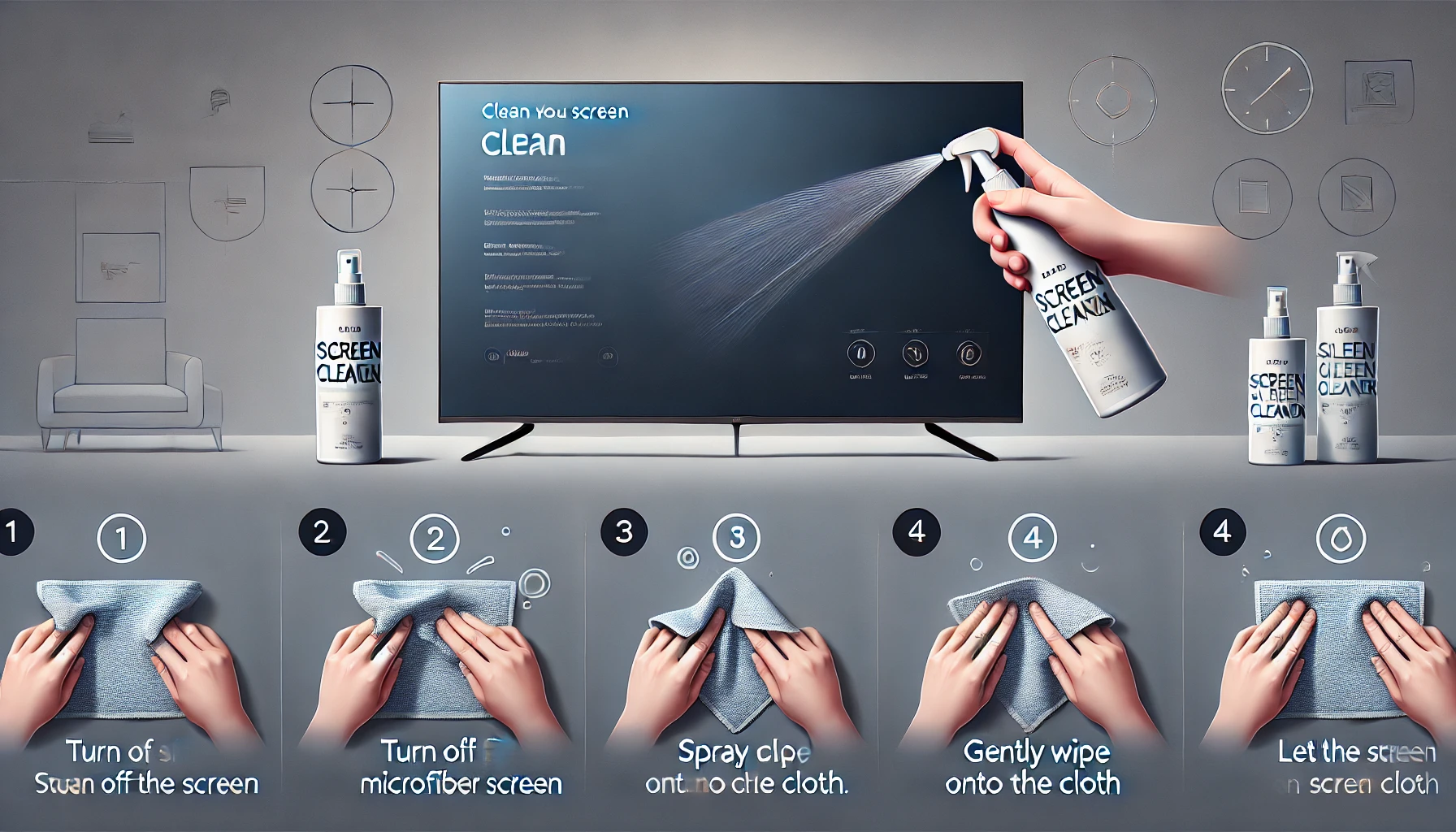Introduction
OLED screens are renowned for their vibrant colors and exceptional display quality, making them a popular choice for televisions, smartphones, and other devices. However, to maintain this high-quality display, it’s crucial to clean the OLED screen properly. Improper cleaning can lead to scratches, smudges, and even permanent damage. In this comprehensive guide, we’ll walk you through the best practices for cleaning an OLED screen, ensuring it remains spotless and performs at its best.
Table of Contents
| Headings | Sub-Topics |
|---|---|
| Understanding OLED Technology | What is OLED? |
| Advantages of OLED Screens | |
| Common Issues with OLED Screens | |
| Preparing to Clean an OLED Screen | Necessary Tools |
| Safety Precautions | |
| Step-by-Step Guide to Cleaning | Turning Off the Device |
| Dusting the Screen | |
| Using a Microfiber Cloth | |
| Applying Cleaning Solutions | |
| Removing Stubborn Stains | |
| Dos and Don’ts of Cleaning | What to Avoid |
| Recommended Practices | |
| Maintaining Your OLED Screen | Regular Cleaning Schedule |
| Preventive Measures | |
| Common Mistakes to Avoid | Overusing Cleaning Solutions |
| Applying Excessive Pressure | |
| Special Considerations | Cleaning Portable Devices |
| Cleaning Large Screens | |
| FAQs | Can I use water to clean my OLED screen? |
| Is it safe to use alcohol-based cleaners? | |
| How often should I clean my OLED screen? | |
| Can I use a regular cloth? | |
| What if there are scratches? | |
| Are screen protectors helpful? | |
| Conclusion | Summary of Key Points |
Understanding OLED Technology
What is OLED?
OLED stands for Organic Light-Emitting Diode. It’s a display technology that uses organic compounds to emit light when an electric current is applied. Unlike traditional LCD screens, OLED screens don’t require a backlight, allowing for thinner displays and deeper blacks. The organic compounds are sandwiched between two electrodes, and when electricity passes through, they emit light. This self-emissive technology is what allows OLEDs to produce perfect blacks and vibrant colors.
Advantages of OLED Screens
OLED screens offer numerous benefits, including:
- Superior color accuracy and contrast: OLED displays provide exceptional color accuracy and contrast ratios, making images appear more lifelike.
- Faster response times: OLED screens have faster refresh rates and response times, which are particularly beneficial for gaming and fast-paced videos.
- Energy efficiency: OLEDs can be more energy-efficient because they don’t require a backlight and can turn off individual pixels to display true black.
- Flexible and lightweight designs: The thinness and flexibility of OLED materials allow for innovative design possibilities, including curved and foldable screens.
Common Issues with OLED Screens
Despite their advantages, OLED screens can suffer from issues such as:
- Image retention (burn-in): Static images left on the screen for extended periods can cause burn-in, where faint ghost images remain visible.
- Sensitivity to static images: Similar to burn-in, static images can temporarily affect the screen’s performance, though this is often reversible.
- Degradation over time: OLED materials can degrade, leading to color shifts or dimming over the life of the display if not properly maintained.
Preparing to Clean an OLED Screen
Necessary Tools
To clean an OLED screen, gather the following tools:
- A soft microfiber cloth: Essential for cleaning without scratching.
- Distilled water: Prevents mineral deposits from tap water.
- Isopropyl alcohol (70% or less): Safe for screens when diluted with water.
- A small spray bottle: For mixing and applying cleaning solutions.
- Compressed air (optional): Useful for removing loose dust and debris.
Safety Precautions
Before starting, consider these precautions:
- Turn off and unplug the device: Reduces the risk of electric shock and helps you see smudges more clearly.
- Avoid harsh chemicals: Harsh chemicals can damage the screen’s coating.
- Work in a dust-free environment: Prevents new particles from settling on the screen during cleaning.
Step-by-Step Guide to Cleaning
Turning Off the Device
Always start by turning off your OLED device and unplugging it from any power source. This reduces the risk of electric shock and allows you to see smudges and dirt more clearly. Allow the screen to cool down if it has been in use, as a warm screen can evaporate cleaning solutions too quickly, leaving streaks.
Dusting the Screen
Use compressed air or a dry microfiber cloth to gently remove any loose dust from the screen. This step is crucial to prevent scratches that could occur if dust particles are rubbed into the screen during cleaning. Hold the can of compressed air upright and at a slight angle to blow away dust without causing damage.
Using a Microfiber Cloth
A microfiber cloth is ideal for cleaning because it’s soft and non-abrasive. Lightly wipe the screen in a circular motion to remove fingerprints and smudges. Microfiber cloths are designed to trap dust and oils, making them more effective than regular cloths. If you notice any areas that need more attention, fold the cloth to a clean section and continue wiping.
Applying Cleaning Solutions
If the screen is still dirty, mix a solution of distilled water and isopropyl alcohol in equal parts. Spray the solution onto the microfiber cloth, not directly onto the screen, and gently wipe the screen. Direct spraying can cause liquid to seep into the edges and potentially damage internal components. Ensure the cloth is damp, not wet, to avoid leaving excess moisture on the screen.
Removing Stubborn Stains
For persistent stains, apply a bit more pressure, but be careful not to press too hard. Reapply the cleaning solution to the cloth as needed. Focus on the affected area and use gentle, circular motions to lift the stain. If the stain persists, you may need to repeat this process several times, allowing the screen to dry between attempts.
Dos and Don’ts of Cleaning
What to Avoid
- Never use paper towels or abrasive cloths: These materials can scratch the delicate surface of the OLED screen.
- Avoid direct spraying of liquids onto the screen: Liquids can seep into the edges and damage internal components.
- Do not use ammonia-based cleaners or other harsh chemicals: These can damage the screen’s anti-reflective coating.
Recommended Practices
- Always use a microfiber cloth: It’s designed to clean without scratching.
- Clean your screen regularly: Prevent the buildup of dirt and oils by maintaining a regular cleaning schedule.
- Store cleaning tools properly: Keep your microfiber cloth and cleaning solution in a clean, dry place to prevent contamination.
Maintaining Your OLED Screen
Regular Cleaning Schedule
Establish a regular cleaning schedule to keep your OLED screen in top condition. Depending on usage, aim to clean it at least once a week. For heavily used devices like smartphones and tablets, more frequent cleaning may be necessary to prevent oil and dirt buildup.
Preventive Measures
- Avoid touching the screen with your fingers: Fingerprints can leave oils that attract dust.
- Use screen protectors: These can prevent direct contact with the screen, reducing the risk of scratches and smudges.
- Keep the device in a dust-free area when not in use: Use protective covers or cases for added protection.
Common Mistakes to Avoid
Overusing Cleaning Solutions
Using too much cleaning solution can leave streaks and residues. Always use it sparingly. A lightly dampened cloth is usually sufficient for most cleaning tasks. Excessive liquid can also seep into the device and cause damage.
Applying Excessive Pressure
Pressing too hard can damage the screen or cause pixel issues. Be gentle and patient while cleaning. If you encounter a stubborn spot, it’s better to clean it multiple times gently than to apply excessive force.
Special Considerations
Cleaning Portable Devices
For smartphones and tablets, the cleaning process is the same, but be mindful of ports and openings. Use a cotton swab to clean around these areas. Avoid letting any liquid enter the ports, and consider using compressed air to blow out dust from speaker grills and other small openings.
Cleaning Large Screens
For large OLED TVs, you might need a larger microfiber cloth or multiple cloths. Work in sections to ensure the entire screen is cleaned evenly. Start from the top and work your way down, using overlapping strokes to avoid streaks. Ensure you have a stable platform to clean from to prevent any accidents.
FAQs
Can I use water to clean my OLED screen?
Yes, but it’s best to use distilled water to avoid mineral deposits. Always apply the water to a microfiber cloth, not directly to the screen.
Is it safe to use alcohol-based cleaners?
Yes, but use isopropyl alcohol that is 70% or less and dilute it with distilled water.
How often should I clean my OLED screen?
It depends on usage, but generally, once a week is sufficient to keep it clean. For devices that see heavy use, consider more frequent cleanings.
Can I use a regular cloth?
No, regular cloths can be abrasive. Always use a microfiber cloth to avoid scratches.
What if there are scratches?
Minor scratches can sometimes be polished out with special screen polishes, but deep scratches may require professional repair.
Are screen protectors helpful?
Yes, screen protectors can prevent direct contact with the screen, reducing the risk of scratches and smudges.
Conclusion
Maintaining the pristine condition of your OLED screen is essential for enjoying its superior display quality. By following the steps outlined in this guide, you can clean your OLED screen safely and effectively, ensuring it remains free from scratches and smudges. Regular maintenance and proper cleaning techniques will extend the life of your OLED screen, providing you with the best possible viewing experience for years to come.


